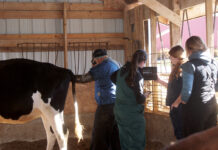BOWLING GREEN, Ohio — Farmers have known AI to mean one thing — the birds and the bees for bulls — for quite some time, but now it’s starting to mean something else.
Artificial Intelligence is set to collide with agriculture in big ways, changing how farmers approach everything from planting to harvest. At the April CIFT Agribusiness Forum, held at the Agricultural Incubator Foundation in Bowling Green, Ohio, experts and growers gathered to consider how AI is reshaping farming operations in very real, practical ways.
Andrew Drerup, director of precision agriculture at Truland Equipment and a 20-year industry veteran, led the conversation, walking attendees through the cutting-edge tools already in the field — like weed-sensing tech, predictive diagnostics and autonomous tractors — and explained how they’re helping farmers do more with less, cut costs and stay ahead in an industry facing labor shortages and shifting demands.
“It’s a calculator”
To kick things off, Drerup asked Microsoft Copilot, an AI assistant, to list five ways AI is being used in agriculture. It only gave him four, including automated decision-making, predictive analytics, precision ag and robotics and automation. He was impressed, anyway.
“It is a computer-based system that looks at what you put in,” Drerup said. “It’s a calculator. It’s calculating what you tell it you want calculated.”
But he cautioned against dystopian fears, with a lighthearted nod to one of Hollywood’s earlier takes on AI, referencing the 2004 Will Smith-led film “i, ROBOT.”
“It’s not an evil, corrupt machine,” he said. “I hope it never gets to the point where we have robots to take over our world and make us think what we shouldn’t think, but that’s not where we’re at. I hope that’s not where we’re headed.”
Instead, Drerup said, today’s AI is all about smart decision-making. That’s especially critical when razor-thin margins leave no room for error.
“Farm profits are less right now. So, anything we can do to be more efficient to help our bottom line is a net positive for us,” he said.
One of the standout tools Drerup discussed is an AI-driven sprayer that activates only specific nozzles based on real-time weed detection.
“What it’s going to do is it’s going to look for that weed and say, ‘That’s the weed.’ It’s going to look for that weed coming towards the (harvester). And then it’s going to say, ‘Okay, the weed’s here. I’m going to turn on this nozzle, this nozzle and this nozzle.”
Real-world application
Drerup shared another real-world application: AI-powered combines using satellite imagery and front-mounted cameras to detect changing crop conditions and automatically adjust.
He recalled a moment in a soybean field where the dust was so thick, he and a colleague couldn’t even see the front of the combine — it was like driving blind through a cloud. His colleague was nervous about hitting a patch of greener, tougher plants that might clog the machine. But Drerup told him to trust the AI system.
Though they couldn’t see it with their eyes, the satellite images showed a change in the crop ahead. And right as the combine reached that spot, the AI automatically slowed the machine down, proving the tech knew what was coming even when they didn’t.
“We could see on the satellite image a change in the crop vegetation was coming,” he said. “And right when we hit that, it pulled the speed back.”
The system uses data from across the growing season to make those split-second adjustments. “It utilizes cameras to do predictive adjustments and ground speed changes in the field,” Drerup said.
And the tech doesn’t stop there. Coming soon, every time a customer calls with a complaint, issue or even just a question, Drerup said AI will log the interaction, including the machine type, serial number, location and even what was said into a central data library, and then offer technicians possible solutions the next time a similar issue comes up. That way, when a service call is placed, the technician often knows the fix and what parts to bring before they even arrive.
As for autonomous equipment, it’s already rolling. John Deere’s driverless tractors were in local fields this spring, but the new tech brings its own set of growing pains.
“We have a few operating in the field this spring,” Drerup said.
Despite the occasional hiccup, he remains optimistic.
“We can either buck it and push back and be behind, or figure out ahead of everybody else,” he said.
Future
And now, thanks to a national education push, the next generation of ag leaders is learning those tools early. On May 6, Microsoft and the National FFA Organization announced the national rollout of FarmBeats for Students, a hands-on educational program teaching middle and high school students about AI, smart sensors and data science in agriculture.
Through the initiative, FFA chapters in 185 schools across the country will receive free FarmBeats kits, including ready-to-use sensors and curriculum that requires no technical background. Students will learn how to build and use environmental sensor systems, track soil moisture and nutrient levels in real time and apply AI to real-world problems like drought or pests, all while gaining critical STEM skills.
“Programs like this equip students with technical knowledge, confidence and adaptability to thrive in diverse and evolving industries. Investing in these young minds today sets the stage for a more sustainable, innovative and resilient agricultural future,” said Christine White, chief program officer at the National FFA Organization, in a press release.










